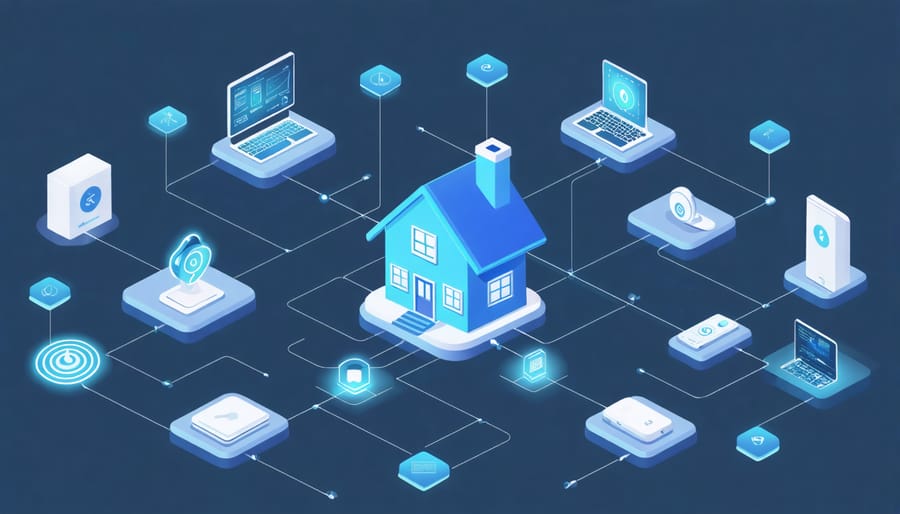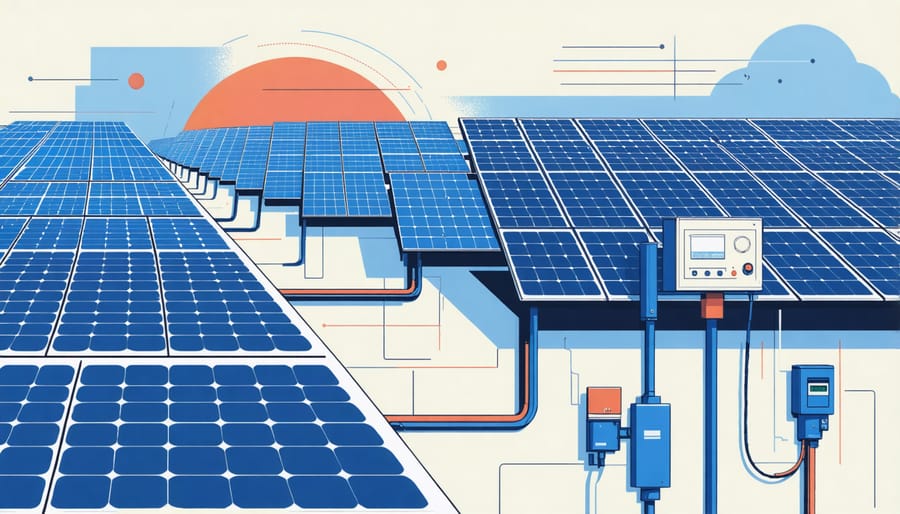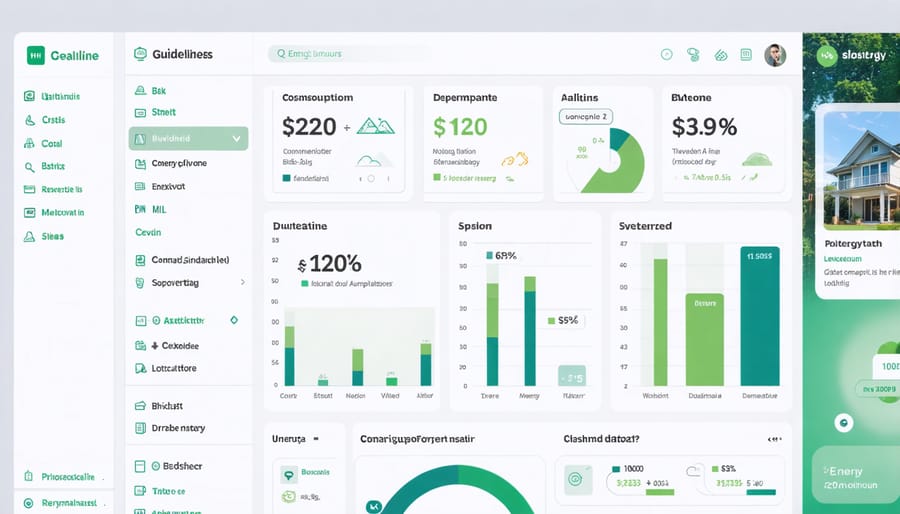Transform your home’s energy landscape by integrating blockchain technology with your existing smart home energy management system. This revolutionary technology is doing for energy what the internet did for information – creating a secure, transparent, and efficient way to generate, store, and trade power right from your rooftop solar panels.
Imagine buying electricity directly from your neighbor’s solar array during peak hours, automatically selling your excess power back to the grid for premium prices, and having every transaction recorded in an unhackable digital ledger. That’s not science fiction – it’s happening right now in communities across the globe.
By combining blockchain with smart meters and home batteries, homeowners are cutting their energy bills by up to 40% while strengthening grid resilience during outages. The technology eliminates middlemen, reduces fees, and puts you in complete control of your home’s energy destiny. Whether you’re looking to minimize your carbon footprint or maximize your energy independence, blockchain provides the secure foundation needed to revolutionize how we power our homes.
Why Your Smart Home Needs Blockchain Security
Current Smart Home Energy Risks
As our homes become increasingly connected, traditional smart home energy systems face several security challenges and inefficiencies that every homeowner should be aware of. Despite advances in smart home security protection, many systems remain vulnerable to cyber threats and data breaches.
One of the biggest risks is unauthorized access to your energy consumption data. Hackers could potentially manipulate your smart meters or thermostats, leading to unexpected energy spikes and higher bills. Additionally, centralized control systems create single points of failure – if the main server goes down, you might lose control of your entire home energy management system.
Energy tracking inefficiencies are another common issue. Traditional systems often struggle with real-time monitoring and accurate reporting, making it difficult to optimize your energy usage effectively. There’s also the challenge of data privacy – your energy consumption patterns can reveal sensitive information about your daily routines and home occupancy.
These vulnerabilities highlight the need for more secure, decentralized solutions that can protect your home’s energy ecosystem while maintaining efficiency and user control.
Blockchain’s Security Shield
Think of blockchain as a digital fortress protecting your home’s energy system. Unlike traditional systems where data is stored in one place, blockchain spreads information across multiple computers, making it extremely difficult for hackers to tamper with your energy data or compromise your smart home setup.
Every energy transaction in your home gets recorded as a “block” and is linked to previous transactions, creating an unbreakable chain. If someone tries to alter any information, the system immediately detects the inconsistency because it doesn’t match the copies stored elsewhere in the network.
This security system works like a neighborhood watch program, but for your energy data. Each participant in the network helps verify and validate transactions, ensuring everything stays legitimate and transparent. For homeowners, this means peace of mind knowing that your energy consumption data, billing information, and smart device controls are protected by one of the most secure technologies available today.
Plus, blockchain’s security features work automatically in the background, requiring no extra effort on your part while keeping your home’s energy system safe and reliable.

Smart Energy Features That Blockchain Enables
Secure Energy Trading with Neighbors
Imagine trading excess solar energy with your neighbor as easily and securely as sending a text message. That’s exactly what blockchain technology makes possible! This innovative system creates a secure digital marketplace where you can buy and sell energy directly with nearby households, eliminating the need for traditional power companies as middlemen.
When your solar panels generate more power than you need, instead of letting it go to waste or selling it back to the grid at low rates, you can sell it directly to neighbors who might need extra energy. Your home energy storage systems work together with blockchain technology to track every bit of energy shared, ensuring all transactions are recorded accurately and permanently.
The beauty of blockchain for energy trading lies in its transparency and security. Each energy transaction is encrypted and added to a digital ledger that can’t be altered or tampered with. Smart contracts automatically handle payments and energy transfers, making the whole process seamless and trustworthy.
Best of all, this peer-to-peer system helps create a more resilient local energy network. When one neighbor’s solar panels are in shade, they can purchase energy from someone else whose panels are in full sun. It’s like having your own neighborhood power plant, operated by and for the community!

Automated Bill Management
Gone are the days of manually checking energy meters and dealing with paper bills. With blockchain-powered smart contracts, managing your home’s energy usage and payments becomes as easy as setting up autopay for your streaming services. These digital agreements automatically track your energy consumption and handle payments in real-time, making billing headaches a thing of the past.
Think of smart contracts as your personal energy accountant, working 24/7 to monitor usage and process payments. When you consume electricity, the system automatically records the amount and calculates the cost based on current rates. If you have solar panels generating excess energy, the same system credits your account instantly when you feed power back to the grid.
The beauty of this automation lies in its transparency and accuracy. You can check your energy usage and costs anytime through a user-friendly dashboard. No more surprise bills or disputed readings – every kilowatt-hour is tracked and verified by the blockchain network. The system can even alert you when usage patterns change or when you’re approaching your preset budget limits.
For households with multiple occupants or rental properties, smart contracts can automatically split bills and handle individual payments. They can also adjust rates based on peak usage times, helping you save money by optimizing when you use certain appliances.
Real-time Energy Monitoring
Imagine having a crystal-clear view of your home’s energy usage, updated every second of the day. That’s exactly what blockchain-powered real-time energy monitoring offers. This innovative system creates an unbreakable digital record of your energy consumption, making it impossible for anyone to tamper with your usage data.
Think of it as a digital energy diary that automatically records every watt of electricity flowing through your home. Each time you turn on your dishwasher, charge your phone, or run your AC, the blockchain creates a permanent, time-stamped entry. This transparent tracking system helps you understand exactly where your energy goes and when you use it most.
The real beauty lies in its reliability. Unlike traditional meters that can be misread or manipulated, blockchain-based monitoring creates an immutable record that both you and your utility provider can trust. You’ll receive instant notifications about unusual energy patterns, helping you catch potential issues before they become costly problems.
For budget-conscious homeowners, this means no more surprise bills at the end of the month. You can watch your energy consumption in real-time and make immediate adjustments to your usage habits. Plus, the system can automatically suggest energy-saving opportunities based on your unique consumption patterns, helping you make smarter decisions about when and how you use power.

Setting Up Blockchain Energy Security at Home
Compatible Smart Home Devices
Ready to make your home smarter and more energy-efficient with blockchain technology? Here’s a roundup of compatible devices that work seamlessly with blockchain energy systems:
Smart Meters
– Emporia Vue Energy Monitor
– Sense Home Energy Monitor
– Powerley Smart Meter
– ChargePoint Home Flex
Solar Integration Systems
– Tesla Powerwall
– SolarEdge Energy Bank
– Enphase Envoy
– LG Energy Solution Home 8
– SMA Sunny Boy Storage
Smart Thermostats
– Nest Learning Thermostat
– ecobee SmartThermostat
– Honeywell Home T9
– Tado Smart Thermostat
Energy Management Hubs
– Samsung SmartThings Energy
– Apple HomeKit
– Google Home Energy Dashboard
– Amazon Alexa Energy Dashboard
EV Charging Stations
– Tesla Wall Connector
– JuiceBox 40
– ChargePoint Home Flex
– Wallbox Pulsar Plus
Battery Storage Systems
– Tesla Powerwall
– LG RESU
– Generac PWRcell
– sonnen eco
Remember that compatibility often depends on your specific blockchain energy platform and local utility provider. Before purchasing any device, check with your energy provider or blockchain solution vendor for the most up-to-date compatibility information. Many of these devices come with user-friendly apps that make monitoring and managing your energy consumption a breeze.
Pro tip: Start with one or two compatible devices and gradually expand your smart energy ecosystem as you become more comfortable with the technology.
Installation Steps
Let’s get you started with implementing blockchain technology for your home energy system. Before diving in, remember that while these steps require some technical know-how, they can lead to significant energy system costs and savings in the long run.
1. Start by upgrading your existing smart meter to a blockchain-compatible model. Contact your local utility provider to check if they offer blockchain-enabled meters.
2. Install a home energy management system (HEMS) that supports blockchain integration. Look for systems with built-in cryptocurrency wallet capabilities.
3. Set up your digital wallet through your HEMS interface. This will store your energy tokens and handle transactions automatically.
4. Connect your renewable energy sources (if any) to the blockchain network through your HEMS. This typically involves installing a small hardware device that acts as a node.
5. Download and configure the recommended blockchain platform app on your smartphone or computer. Popular options include Energy Web Chain or Power Ledger.
6. Link your smart meter and HEMS to the blockchain platform using the unique identification codes provided with your devices.
7. Set up automated energy trading preferences through your HEMS, including maximum purchase prices and minimum selling rates for excess energy.
8. Test the system by monitoring a few transactions. Your dashboard should show real-time energy production, consumption, and trading activities.
Remember to regularly update your system’s software and backup your digital wallet credentials. Start with small transactions until you’re comfortable with the system’s operation.
Maintenance Tips
Keeping your blockchain energy system running smoothly doesn’t have to be complicated. Here are some essential maintenance tips to help you get the most out of your setup.
First, regularly monitor your system’s performance through your dashboard. Look for unusual patterns in energy consumption or unexpected changes in transaction speeds. Set up automated alerts to notify you of any significant deviations from normal operation.
Back up your private keys and access credentials monthly, storing them in a secure location. Consider using both digital and physical backup methods for added security. Remember to update your system’s software whenever new versions become available – these updates often include important security patches and performance improvements.
Check your network connectivity daily. A stable internet connection is crucial for maintaining seamless blockchain operations. Consider installing a backup internet solution to prevent system interruptions.
Clean your hardware components every three months to prevent dust buildup and overheating. Pay special attention to cooling fans and vents. If you’re using solar panels as part of your system, ensure they’re clean and unobstructed for optimal energy generation.
Regularly review your smart contracts and automated settings quarterly. This helps ensure your energy trading parameters still align with your needs and current market conditions. Consider consulting with a blockchain energy specialist annually for a comprehensive system check-up and optimization recommendations.
Maintain detailed logs of system maintenance and any issues encountered. This documentation can be invaluable for troubleshooting and improving system performance over time.
As we’ve explored throughout this article, blockchain technology is revolutionizing how we manage and control our home energy systems. The combination of smart home technology and blockchain creates a secure, efficient, and cost-effective way to monitor and optimize our energy usage. By implementing blockchain in our home energy systems, we gain unprecedented control over our energy consumption while contributing to a more sustainable future.
The benefits are clear: enhanced security for our energy data, automated energy trading capabilities, reduced utility costs, and improved transparency in energy consumption. What’s particularly exciting is that this technology is becoming increasingly accessible to everyday homeowners, with user-friendly interfaces and simplified setup processes making adoption easier than ever.
Looking ahead, the potential for blockchain in smart home energy systems is boundless. We can expect to see more innovative applications, from advanced peer-to-peer energy trading networks to sophisticated energy management systems that learn and adapt to our habits. As more homeowners embrace this technology, we’ll likely see decreased energy costs, improved grid reliability, and a more sustainable energy ecosystem.
Whether you’re just starting your smart home journey or looking to upgrade your existing system, incorporating blockchain technology is a forward-thinking investment that promises both immediate and long-term benefits for your home and the environment.
